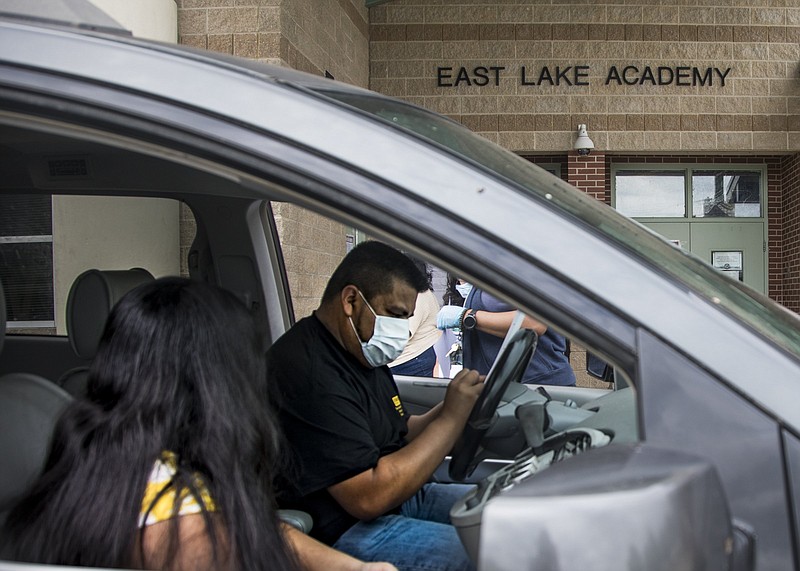How did we miss this?
Each passing week, we learn new and more sobering information about COVID-19 and its impact on our communities, states and nation.
Last week, as case numbers grew, we saw that a single ZIP code representing some of Chattanooga's most at-risk neighborhoods had gone from having a handful of COVID-19 cases to a local hot spot of them, with one of every six county cases now coming from the 37407 area, which includes the Clifton Hills and East Lake neighborhoods.
That ZIP code represents less than 3% of Hamilton County's population, but is now home to between 10% and 18% of the county's COVID-19 cases, according to data from the Hamilton County Health Department.
It also is more racially diverse than the rest of the county, with nearly 40% of residents being black or African American and more than 25% Hispanic, according to U.S. Census Bureau data. The area has a poverty rate nearly four times higher than the county, with 45% of the population living below the federal poverty line, according to the census. And nearly 40% of households there do not have access to internet, compared to 15% in the county as a whole.
Thus, ZIP code 37407 becomes the poster child of a vulnerable community that has been underserved throughout the epidemic. Until those numbers surfaced, it had appeared that our COVID-19 cases mirrored the area's racial demographics. Now reality has caught up with us.
"There were so many people at the table who were patting themselves on the back for doing a good job, but they were ignoring the minority voice on the table that was saying, 'You're missing an entire group of people in Chattanooga,'" said Esai Navarro, a community organizer with TN United told the Times Free Press.
How can that happen? Navarro explained it. She had the realization near the end of March. While thousands of residents were working from home or waiting in line before sunrise for supplies at Walmart, she walked into a local Spanish store to find no shortage of food. The shelves were stocked full of toilet paper.
Organizers with her group began calling residents to see what they knew, she said.
"We realized they had no idea that COVID-19 was in Chattanooga. And we already had eight cases."
The information about the coronavirus, about the risks and the safety precautions, about the resources were being broadcast by politicians and the health department, but it was not reaching that critical portion of the population.
Spanish versions of Hamilton County Government news conferences discussing the latest coronavirus updates appear on the organization's YouTube page between three and 10 days after the briefing. The first and only video in Spanish on the Hamilton County Health Department's page, explaining how to make a face covering, was posted May 8, 56 days after the first reported case in the county. And not for a full month after the county's first COVID-19 case was confirmed, did the county announce Clinica Medicos as a testing site in a focused effort to reach people without health insurance, a primary care provider or a personal vehicle.
Even the Health Department's response to the ZIP code spike seemed dismissive: "Individuals travel about in the county to work, shop, attend school and/or other functions," the department said in a statement. "We feel focus on following the basic prevention practices (social distancing; wearing of masks when out in public or in places where distance; not going to work when sick; and covering your cough) would be more helpful than focusing on specific ZIP codes."
We found and tested the vulnerable elderly in nursing homes. We made a concerted effort to test in jails. But we missed this ZIP code. Who else are we missing?
Trump is right, Bright is wrong
Do you think President Trump is correct in calling Rick Bright, the Department of Health and Human Services whistleblower, disgruntled?
Well, sure he's right. Of course Bright was disgruntled. And with good reason.
His urgent warnings of an impending shortage of N95 respirator masks were ignored by his superiors and the administration in January and early February. He was watching deliberate indifference to a looming crisis. He was living a nightmare that happened to be real.
On Thursday, Bright laid bare the multiple failings of this Trump administration - pushing discredited drug cures, refusing to plan ahead for production and purchase of masks, etc. Worse still, the administration has no "single point of leadership right now for this response, and we don't have a master plan for this response."
On that, Bright is wrong. There was and still is a single point: Trump.
We've no time for Trump fatigue
We've heard in the past week from several people that they suffer Trump fatigue, and they begged respite.
Well, no one - no one - is more tired of Donald J. Trump than this page editor. But that's just too bad.
Now is not the time to put our fingers in our ears and sing lalalala. There are less than six months until Election Day.
Look at the damage Trump has inflicted on our country in three-and-a-half years. We cannot give him any more time.
